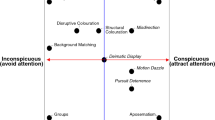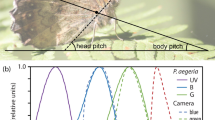Abstract
We describe for the first time the visual fields of the largest tropical raptor, the Harpy Eagle (Harpia harpyja), a powerful keystone species that hunts almost exclusively in forested habitats. They have the largest blind area described to date of any diurnal raptor species, and relatively narrow binocular fields, which together may help explain the way they interact with their prey in the visually complex environments they inhabit. As a top predator, their spatial visual sampling is likely driven more by foraging needs than predator detection, and they thus serve as an excellent study species for understanding the tradeoffs between visually guided foraging and anti-predatory behaviors. Further studies on the position and the projection of retinal foveae, visual acuity, and color vision will improve our understanding of their visual capabilities and could play important roles in conservation of a vulnerable Neotropical species.
Zusammenfassung
Das Gesichtsfeld der Harpyie ( Harpia harpyja )
Wir beschreiben hier zum ersten Mal das Gesichtsfeld des größten tropischen Greifvogels, der Harpyie (Harpia harpyja), einer wichtigen Schlüsselart, die fast ausschließlich in bewaldeten Lebensräumen jagt. Die Tiere haben den größten bisher beschriebenen blinden Bereich aller tagaktiven Greifvogelarten und relativ schmale Sehfelder, was erklären könnte, auf welche Weise sie mit ihrer Beute in der visuell komplexen Umgebung, in der diese lebt, interagieren. Als ausgeprägter Räuber wird ihr räumliches visuelles Erfassen der Umgebung wahrscheinlich eher von der Nahrungssuche als durch das Aufspüren von Raubtieren bestimmt, und sie sind daher als Art hervorragend geeignet für Untersuchungen zum Verständnis der Nutzen-/Kosten-Analyse von visuell gesteuerter Nahrungssuche versus Anti-Raubtier-Verhalten. Weitere Studien zur Position und Projektion der Netzhautfurchen, der Sehschärfe und des Farbsehens können unser Verständnis der visuellen Fähigkeiten der Harpyie vertiefen und eine wichtige Rolle bei der Erhaltung einer gefährdeten neotropischen Art spielen.


Similar content being viewed by others
Availability of data and materials
Data and code used for some figures are available at the following public repository: https://osf.io/xk5qn/.
Code availability
Not applicable.
References
Aguiar-Silva FH (2014) Food habits of the Harpy Eagle, a top predator from the Amazonian rainforest canopy. J Rap Res 48:24–35
Bierregaard RO (1994) Harpy Eagle. In: del Hoyo J, Elliott A, Sargatal J (eds) Handbook of birds of the world, vol 2. Lynx Edicions, Barcelona, Spain, p 191
Birdlife International (2022) Harpia harpyja (American Harpy Eagle, Harpy Eagle). Available at http://datazone.birdlife.org/species/factsheet/22695998. Accessed 4 Apr 2022.
Brown L, Amadon D (1968) Eagle, hawks and falcons of the world. McGraw-Hill, New York, New York
Cavalcante T, Tuyama CA, Mourthe I (2019) Insights into the development of a juvenile harpy eagle’s hunting skills. Acta Amazon 49:114–117
Changizi MA, Shimojo S (2008) “X-ray vision” and the evolution of forward-facing eyes. J Theor Biol 254:756–767
Christie DA (2001) Raptors of the world. Houghton Mifflin Harcourt, pp 717–719
Dunning JB (2007) CRC handbook of avian body masses, 2nd edn. CRC Press, Chicago/Turabian, Boca Raton
Fernández-Juricic E, Gall MD, Dolan T, Tisdale V, Martin GR (2008) The visual fields of two ground-foraging birds, house finches and house sparrows, allow for simultaneous foraging and anti-predator vigilance. Ibis 150:779–787
Fox R, Lehmkuhle SW, Bush RC (1977) Stereopsis in the falcon. Science 197:79–81
Guillemain M, Martin GR, Fritz H (2002) Feeding methods, visual fields and vigilance in dabbling ducks (Anatidae). Func Ecol 16:522–529
Heesy CP (2009) Seeing in stereo: the ecology and evolution of primate binocular vision and stereopsis. Evol Anthropol 18:21–35
Izor RJ (1985) Sloths and other mammalian prey of the Harpy Eagle. In: Montgomery GG (ed) The evolution and ecology of armadillos, sloths, and vermilinguas. Smithsonian Institution, Washington, D.C., pp 343–346
Jones MP, Pierce KE Jr, Ward D (2007) Avian vision: a review of form and function with special consideration to birds of prey. J Exotic Pet Med 16:69–87
Kane S, Zamani M (2014) Falcons pursue prey using visual motion cues: new perspectives from animal-borne cameras. J Exp Biol 217:225–234
Martin GR (1984) The visual fields of the tawny owl, Strix aluco. Vision Res 24:1739–1751
Martin GR (2007) Visual fields and their functions in birds. J Ornithol 148:S547–S562
Martin GR (2009) What is binocular vision for? A birds’ eye view. J vis 9:1–19
Martin GR (2014) The subtlety of simple eyes: the tuning of visual fields to perceptual challenges in birds. Phil Trans R Soc B Biol Sci 369:20130040
Martin GR (2017) What drives bird vision? Bill control and predator detection overshadow flight. Front Neurosci 11:619
Martin GR, Katzir G (1999) Visual fields in short-toed eagles, Circaetus gallicus (Accipitridae), and the function of binocularity in birds. Brain Behav Evol 2:55–66
Martin GR, Katzir G (2000) Sun shades and eye size in birds. Brain Behav Evol 56:340–344
Martin GR, Portugal SJ, Murn CP (2012) Visual fields, foraging and collision vulnerability in Gyps vultures. Ibis 154:626–631
Matola S (2006) The Harpy Eagle restored to former Central American range. Oryx 40:13
Mendelsohn JM, Kemp AC, Biggs HC, Biggs R, Brown CJ (1988) Wing areas, wing loading and wing spans of 66 species of African raptors. Ostrich 60:35–42
Miranda EBPd, Campbell-Thompson E, Muela A, Hernán-Vargas F (2017) Sex and breeding status affect prey composition of Harpy Eagles Harpia harpyja. J Ornithol 159:141–150
Miranda EBPd, Kenup CF, Campbell-Thompson E, Vargas FH, Muela A, Watson R, Peres CA, Downs CT (2020) High moon brightness and low ambient temperatures affect sloth predation by harpy eagles. Peer J 8:e9756
Mitkus M, Potier S, Martin GR, Duriez O, Kelber A (2018) Raptor vision. Oxford research encyclopedia of neuroscience. Oxford University Press, Oxford, UK, pp 5–6
Moore BA, Montiani-Ferreira F (2022) Ophthalmology of Accipitrimorphae, Strigidae, and Falconidae: eagles, hawks, vultures, owls, falcons, and their relatives. In: Montiani-Ferreira F, Moore BA, Ben-Shlomo G (eds) Wild and exotic animal ophthalmology, volume 1: invertebrates, fishes, amphibians, reptiles, and birds. Springer Nature, Switzerland, pp 429–504
Moore BA, Doppler M, Young JE, Fernández-Juricic E (2013) Interspecific differences in the visual system and scanning behavior of three forest passerines that form heterospecific flocks. J Comp Physiol A 199:263–277
Moore BA, Pita D, Tyrrell LP, Fernández-Juricic E (2015) Vision in avian emberizid foragers: maximizing both binocular vision and fronto-lateral visual acuity. J Exp Biol 218:1347–1358
Moore BA, Tyrrell LP, Kamilar JM, Collin S, Dominy NJ, Hall MI, Heesy CP, Lisney TJ, Loew ER, Moritz GL, Nava SS, Warrant E, Shaw K, Fernandez-Juricic E (2017a) Structure and functions of regional specializations in vertebrate retinas. In: Kaas JH, Striedter G (eds) Evolution of nervous systems, 2nd edn. Elsevier, Oxford, UK, pp 351–372
Moore BA, Tyrrell LP, Pita D, Bininda-Emonds ORP, Fernandez-Juricic E (2017b) Does retinal configuration make the head and eyes of foveate birds move? Sci Rep 7:38406
O’Rourke CT, Hall MI, Pitlik T, Fernández-Juricic E (2010a) Hawk eyes I: diurnal raptors differ in visual fields and degree of eye movement. PLoS One 5:e12802
O’Rourke CT, Pitlik T, Hoover M, Fernández-Juricic E (2010b) Hawk eyes II: diurnal raptors differ in head movement strategies when scanning from perches. PLoS One 5:e12169
Orihuela G, Terborgh J, Ceballos N, Glander K (2014) When top-down becomes bottom up: behaviour of hyperdense howler monkeys (Alouatta seniculus) trapped on a 0.6 Ha island. PloS One 9:e82197
Payne RS (1971) Acoustic location of prey by barn owls (Tyto alba). J Exp Biol 54:535–573
Pettigrew JD (1978) Comparison of the retinotopic organization of the visual wulst in nocturnal and diurnal raptors, with a note on the evolution of frontal vision. In: Cool SJ, Smith EL (eds) Frontiers in visual science, springer series in optical sciences, vol 8. Springer, Berlin, Heidelberg
Pettigrew JD, Konishi M (1976) Neurons selective for orientation and binocular disparity in the visual wulst of the barn owl (Tyto alba). Science 193:675–678
Pita D, Moore BA, Tyrrell LP, Fernández-Juricic E (2015) Vision in two cyprinid fish: implications for collective behavior. Peer J. https://doi.org/10.7717/peerj.1113
Portugal SJ, Murn CP, Martin GR (2017) White-headed vulture Trigonoceps occipitalis shows visual field characteristics of hunting raptors. Ibis 159:463–466
Potier S (2020) Visual adaptations in predatory and scavenging diurnal raptors. Diversity 12:400
Potier S, Bonadonna F, Kelber A, Martin GR, Isard P-F, Dulaurent T, Duriez O (2016) Visual abilities in two raptors with different foraging ecologies. J Exp Biol 219:2639–2649
Potier S, Bonadonna F, Martin GR, Isard P-F, Dulaurent T, Mentek M, Duriez O (2017) Visual configuration of two species of Falconidae with different foraging ecologies. Ibis 160:54–61
Potier S, Duriez O, Cunningham GB, Bonhomme V, O’Rourke C, Fernandez-Juricic E, Bonadonna F (2018) Visual field shape and foraging ecology in diurnal raptors. J Exp Biol. https://doi.org/10.1242/jeb.177295
Potier S, Mitkus M, Kelber A (2020) Visual adaptations of diurnal and nocturnal raptors. Semin Cell Dev Biol 106:116–126
Rettig NL (1978) Breeding behavior of the Harpy Eagle (Harpia harpyja). Auk 95:629–643
Sutton LJ, Anderson DL, Franco M, Gomes FBR, McClure CJW, Miranda EBP, Vargas FH, Vargas Gonzalez JJ, Puschendorf R (2022) Habitat resource overlap in two broad-ranged sympatric neotropical forest eagles. bioRxiv. https://doi.org/10.1101/2022.03.24.485595
Thiollay JM (1994) Harpy Eagle (Harpia harpyja). In: del Hoy J, Elliott A, Sargatal J (eds) Handbook of the birds of the world, volume 2, new world vultures to Guineafowl. Lynx Edicions, Barcelona, Spain, p 191
Touchton JM, Hsu Y-C, Palleroni A (2002) Foraging ecology of reintroduced captive-bred subadult harpy eagles (Harpia harpyja) on Barro Colorado Island, Panama. Ornitol Neotrop 13:365–379
Trinca CT, Ferrari SF, Lees AC (2008) Curiosity killed the bird: arbitrary hunting of Harpy Eagles Harpia harpyja on an agricultural frontier in Southern Brazilian Amazonia. Cotinga 30:12–15
Troscianko J, von Bayern AMP, Chappell J, Rutz C, Martin GR (2012) Extreme binocular vision and a straight bill facilitate tool use in New Caledonian crows. Nature Comm 3:1110
Tucker VA (2000) The deep fovea, sideways vision and spiral flight paths in raptors. J Exp Biol 203:3745–3754
Tyrrell LP, Fernández-Juricic E (2017) The hawk-eyed songbird: retinal morphology, eye shape, and visual fields of an aerial insectivore. Am Nat 189:709–717
van der Willigen RF, Frost BJ, Wagner H (1988) Stereoscopic depth perception in the owl. Neuroreport 9:1233–1237
Vargas D, Whitacre D, Mosquera R, Albuquerque J, Piana R, Thiollay J-M, Márquez C, Sánchez JE, Lezama-Lópes M, Midence S, Matola S, Aguilar S, Rettig N, Sanaiotti (2006) Estado y distribución actual del águila arpía (Harpia harpyja) en Centro y Sur America. Ornitologia Neotropical 17:39–55
Vargas-Gonzalez JJ, McCabe JD, Anderson DL, Curti M, Cardenas DC, Vargas FH (2020) Predictive habitat model reveals specificity in a broadly distributed forest raptor, the harpy eagle. J Raptor Res 54:349–363
Wagner H, Frost B (1994) Binocular responses of neurons in the barn owl’s visual Wulst. J Comp Physiol A 174:661–670
Wallman J, Pettigrew JD (1985) Conjugate and disjunctive saccades in two avian species with contrasting oculomotor strategies. J Neurosci 5:1418–1428
Funding
This study did not utilize financial support or grants.
Author information
Authors and Affiliations
Corresponding author
Ethics declarations
Conflict of interest
No author has any competing financial or non-financial interests to disclose.
Ethical approval
All animal housing, handling, and procedures were approved by and were in compliance with the ethical standards set by the Universidade Federal do Paraná, Setor de Ciências Agrárias, Comissão de Ética no Uso de Animais (protocol number 075/2016).
Human and animal participants
Not applicable.
Consent to participate
All authors agreed to participate in this manuscript.
Consent for publication
All authors read and approved results in this manuscript.
Additional information
Communicated by F. Bairlein.
Publisher's Note
Springer Nature remains neutral with regard to jurisdictional claims in published maps and institutional affiliations.
Rights and permissions
Springer Nature or its licensor (e.g. a society or other partner) holds exclusive rights to this article under a publishing agreement with the author(s) or other rightsholder(s); author self-archiving of the accepted manuscript version of this article is solely governed by the terms of such publishing agreement and applicable law.
About this article
Cite this article
Brewer, A.E., de Moraes, W., Ferreira, T.A.C. et al. The visual fields of the Harpy Eagle (Harpia harpyja). J Ornithol 164, 651–658 (2023). https://doi.org/10.1007/s10336-023-02054-y
Received:
Revised:
Accepted:
Published:
Issue Date:
DOI: https://doi.org/10.1007/s10336-023-02054-y




